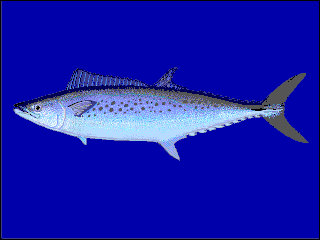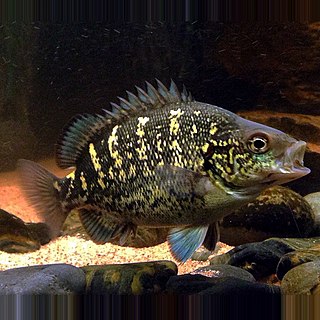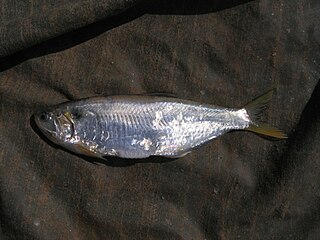
Carpet sharks are sharks classified in the order Orectolobiformes. Sometimes the common name "carpet shark" is used interchangeably with "wobbegong", which is the common name of sharks in the family Orectolobidae. Carpet sharks have five gill slits, two spineless dorsal fins, and a small mouth that does not extend past the eyes. Many species have barbels.

Edward Pierson Ramsay FRSEFLS LLD was an Australian zoologist who specialised in ornithology.

The fauna of New Guinea comprises a large number of species of mammals, reptiles, birds, fish, invertebrates and amphibians.
Cinetodus froggatti, known as Froggatt's catfish or smallmouthed salmon catfish, is a species of sea catfish found in West Papua in Indonesia and Papua New Guinea where it is found in the Purari, Fly, Strickland and Digul River systems as well as in the Roper River system of Northwest Territories, Australia.

Thryssa is a genus of anchovies in the family Engraulidae. It contains the following species:

The Australian spotted mackerel is a species of fish in the family Scombridae. Common fork length ranges between 50 and 80 cm. Specimens have been recorded at up to 104 cm in length, and weighing up to 10.2 kg. It is found in the western Pacific, along the northern coast of Australia, from the Abrolhos Islands region of Western Australia to Coffs Harbour and Kempsey in central New South Wales. It is also found in southern Papua New Guinea from Kerema to Port Moresby. It feeds largely on fishes, particularly anchovies and sardines, with smaller quantities of shrimps and squids. It is sometimes confused with Japanese Spanish mackerel, S. niphonius. Conservation status of the species has been evaluated as Near Threatened by the IUCN. This species was described in 1980 and was previously confused with the Japanese Spanish mackerel of the north western Pacific but S. munroi has a different visceral structure, more vertebrae and fewer gill rakers.

Hephaestus carbo, the coal grunter or black grunter, is a species of freshwater ray-finned fish, a grunter from the family Terapontidae. It is endemic to rivers in northern Australia.

Leiognathus longispinis, commonly known as the longspine- or Smithurst's ponyfish, is a fish of brackish and marine waters found in the Indian and western Pacific Oceans, from India through Malaysia and Indonesia south to northern Australia and east to the Philippines and Fiji It was described in 1835 by French Zoologist Achille Valenciennes from a specimen caught off Waigeo island in Irian Jaya in New Guinea. In 1886 Ramsay and Ogilby described what turned out to the same species from Hood Lagoon in Papua New Guinea, naming it Leiognathus smithursti. In 2008, ichthyologists Prosanta Chakrabarty and John S. Sparks resurrected the genus Aurigequula and placed L. longispinis and L. fasciatus in it, on the basis of a horizontal row of yellow markings on their flanks and elongated second spine of the dorsal fin. However, a molecular study showed that the genus Leiognathus was nested within Aurigequula, and hence the genera were merged once more. Fishbase places this species in Leiognathus while retaining the striped ponyfish in the monotypic Aurigequula.

Thryssa hamiltonii, or Hamilton's thryssa, is a species of ray-finned fish in the family Engraulidae. It is found in the tropical western Indo-Pacific region: mainly, the eastern direction near Myanmar, Taiwan, the northern head of Australia and Papua New Guinea and possibly the Philippines.

Thryssa encrasicholoides, the false baelama anchovy or New Jersey anchovy, is a species of ray-finned fish in the family Engraulidae. It is found in the all marine, brackish and freshwater systems. It is closely related to Thryssa baelama, where the two different only by small structural aspects such as more caudal vertebrae and 1 or 2 keeled scutes without arms.
Thryssa gautamiensis, the gautama thryssa, is a species of amphidromous ray-finned fish in the family Engraulidae.

Thryssa malabarica, the Gautama thryssa or Malabar anchovy, is a species of amphidromous ray-finned fish in the family Engraulidae. It is known as Balal parattaya බළල් පරට්ටයා in Sinhalese.
The thick-lipped catfish is a species of catfish in the family Ariidae. It was described by Edward Pierson Ramsay and James Douglas Ogilby in 1886, originally under the genus Hemipimelodus. It is found in freshwater rivers in New Guinea. It reaches a standard length of 50 cm (20 in). Its diet consists of insects and vascular plants.
Thryssa dayi, the Day's thryssa, is a species of ray-finned fish in the family Engraulidae. It is found in the Western Indian Ocean.
Thryssa adelae, the Swatow thryssa, is a species of ray-finned fish in the family Engraulidae. It is found in the Northwest Pacific Ocean.
Thryssa baelama, the Baelama anchovy, is a species of ray-finned fish in the family Engraulidae. It is found in the Indo-Pacific.
Thryssa kammalensoides, the Godavari thryssa, is a species of ray-finned fish in the family Engraulidae. It is found in the Western Indian Ocean.
Thryssa polybranchialis, the humphead thryssa, is a species of ray-finned fish in the family Engraulidae. It is found in the Indian Ocean.
Thryssa whiteheadi, the Whitehead's thryssa, is a species of ray-finned fish in the family Engraulidae. It is found in the Western Indian Ocean.
Thryssa kammalensis, the Kammal thryssa, is a species of ray-finned fish in the family Engraulidae. It is found in the west Indo Pacific.











